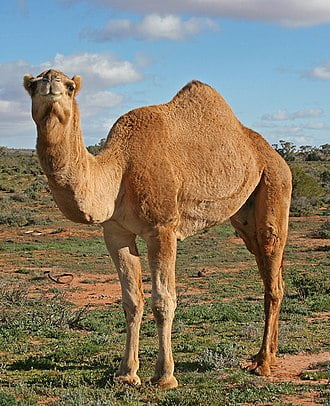Camel

A camel is an even-toed ungulate in the genus Camelus that bears distinctive fatty deposits known as “humps” on its back. Camels have long been domesticated and, as livestock, they provide food (milk and meat) and textiles (fiber and felt from hair). Camels are working animals especially suited to their desert habitat and are a vital means of transport for passengers and cargo. There are three surviving species of camel.
The one-humped dromedary makes up 94% of the world’s camel population, and the two-humped Bactrian camel makes up 6%. The Wild Bactrian camel is a separate species and is now critically endangered.
The word camel is also used informally in a wider sense, where the more correct term is “camelid”, to include all seven species of the family Camelidae: the true camels (the above three species), along with the “New World” camelids: the llama, the alpaca, the guanaco, and the vicuña.[7] The word itself is derived via Latin: camelus and Greek: κάμηλος (kamēlos) from Hebrew, Arabic or Phoenician: gāmāl.
The average life expectancy of a camel is 40 to 50 years.[12] A full-grown adult dromedary camel stands 1.85 m (6 ft 1 in) at the shoulder and 2.15 m (7 ft 1 in) at the hump.[13] Bactrian camels can be a foot taller. Camels can run at up to 65 km/h (40 mph) in short bursts and sustain speeds of up to 40 km/h (25 mph).[14] Bactrian camels weigh 300 to 1,000 kg (660 to 2,200 lb) and dromedaries 300 to 600 kg (660 to 1,320 lb). The widening toes on a camel’s hoof provide supplemental grip for varying soil sediments.[15]
The male dromedary camel has an organ called a dulla in its throat, a large, inflatable sac he extrudes from his mouth when in rut to assert dominance and attract females. It resembles a long, swollen, pink tongue hanging out of the side of its mouth.[16] Camels mate by having both male and female sitting on the ground, with the male mounting from behind.[17] The male usually ejaculates three or four times within a single mating session.[18] Camelids are the only ungulates to mate in a sitting position.[
